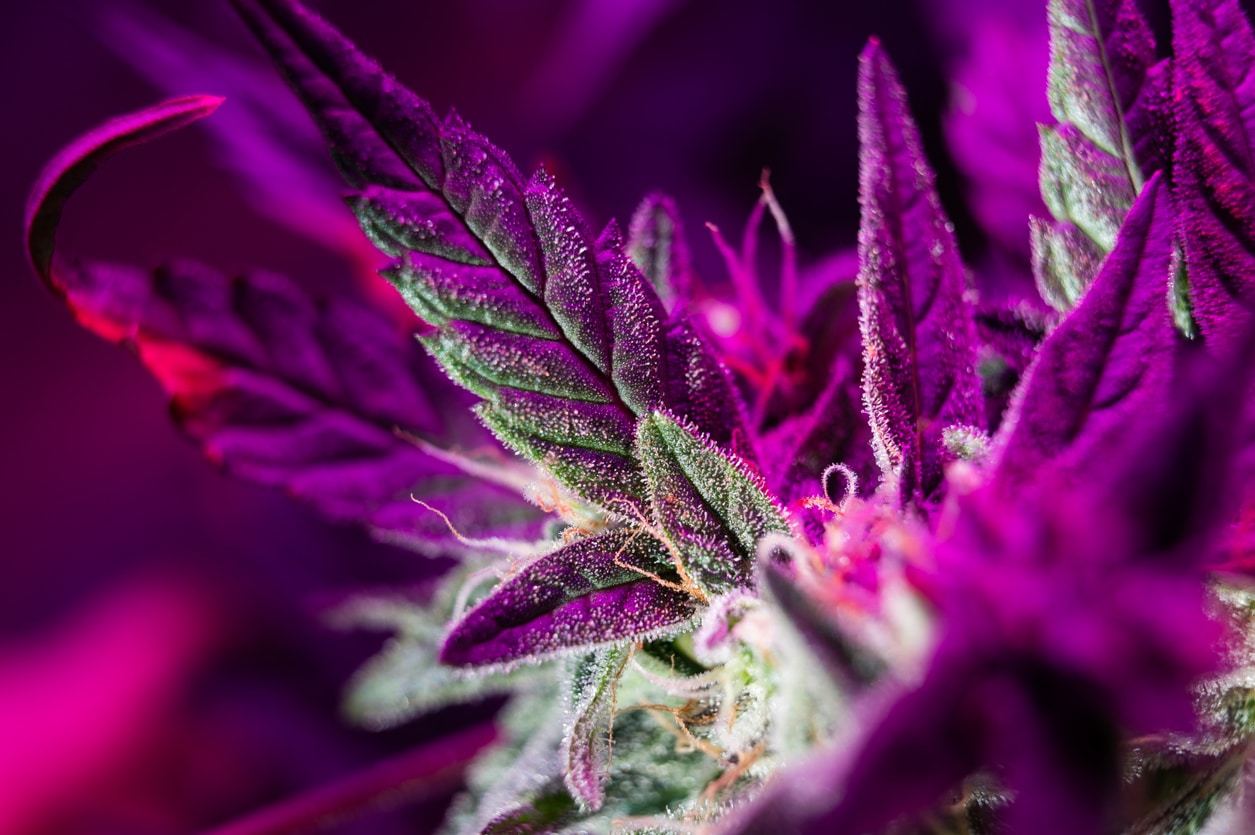We love cannabis for many reasons, from its rich aroma to its fantastic range of colors, from green to reddish, blueish, and even black. How far do these characteristics affect THC potency, though?
Like other plants, cannabis comes in many shapes: tall, stocky, or slender. Cannabis strains differ immensely between them. Another characteristic that sets them apart is color. Purple, red, pink, yellow, and blue hues give cannabis stunning looks, making us want to try them all.
But does the color of the cannabis determine the potency? Unfortunately, the answer is a bit more complicated.
Chlorophyll, Flavonoids, Anthocyanins, and Carotenoids
The color cannabis displays depend on several traits, including strain type, soil, temperature, and maturity. Cannabis growers can tweak the growing conditions to make the underlying colors more vibrant and eye-catching.
Contrary to what some think, however, cannabis color is unrelated to THC potency. Colors are brought out through the flavonoids found in cannabis, whereas THC is a cannabinoid. The various colors are signs of flavonoid activity—which have antioxidant properties but do not affect THC potency.
Chlorophyll, the Green Giant
To better understand how cannabis gets its colors, you should start with plant biology. Most plants are green due to chlorophyll—a pigment that is activated by sunlight and turns plants green.
Plants use chlorophyll to absorb sunlight. Sunlight is a form of energy that plants use to turn carbon dioxide and water into sugars. These sugars feed the plant and help it grow. When it’s summer, chlorophyll is abundance, which is why all plants are very green and the reason why plants grow the most during warm sunny weather.
Chlorophyll is the most abundant plant pigment, typically comprising around 70% of the total pigments in the plant. It is not the only one, though. When fall comes, and sunlight diminishes, red, purple, brown, and orange pigments get to shine. These pigments remain overshadowed by chlorophyll in the summer but can finally appear as chlorophyll diminishes. This is why leaves turn auburn in the fall.
Flavonoids and Anthocyanins
Cannabinoids and chlorophyll are just a few of the compounds found in plants. Others include flavonoids, anthocyanins, and carotenoids.
Flavonoids are found in the leaves, stems, roots, and flowers of plants. They are plant compounds with potential antioxidant and anti-inflammatory properties. Flavonoids give plants their colors, which is why we have such a huge array of plant colors.
Anthocyanins are a group of flavonoids responsible for giving plants blue and purple hues. For example, blackberries, blueberries, eggplants, currants, and grapes are brimming with anthocyanins.
Another category of flavonoids is carotenoids, which, as the name suggests, give plants their orange hues. Carrots, red peppers, watermelon, grapefruit, sweet potatoes, squash, and tomatoes contain carotenoids.
Cannabis contains both anthocyanins and carotenoids. The percentage of each of these flavonoids depends on the strain. Some strains are brimming with anthocyanins, so they will display intense blue hues when they mature. Others have concentrated carotenoids and will be red and orange.
Some very dark, almost black, cannabis strains contain large quantities of anthocyanins but very few other flavonoids—hence the strong expression of anthocyanin colors.
Conversely, white strains contain few flavonoids. As the chlorophyll fades away, the other colors are subdued—almost white.
With over 700 marijuana strains, the combinations are endless, which is part of the beauty of cannabis.
Cannabis Strains and Flavonoid Display
Like most plants, cannabis plants start with green leaves. After all, chlorophyll is the most abundant pigment and the most prominent in the summer.
As summer gives way to fall and temperatures drop, other pigments start showing up. Which ones, depends on the strain. By harvest time, each strain will display its own color palette that is particular to its genes.
Without discounting genetics, there are specific ways that cannabis growers can enhance the vibrancy of their cannabis crop. After all, cannabis is very responsive to growing conditions, to the point that cannabis grown at high altitudes will have different properties from that produced at low ones.
pH Soil Levels
The acidity or alkalinity of the soil can directly affect the color display. Acidic soils will bring out red and pink hues, while neutral soils will highlight purple colors and alkaline ones will promote blue hues.
If a grower can interfere with their soil’s pH levels, their marijuana plants will be affected. Of course, soil intervention can only bring out the inherent flavonoids of each strain. Each strain is predisposed, by nature, to show specific colors particular to its genetic structure.
Thus, if a cannabis strain has a lot of carotenoids, turning the soil more acidic will deliver highly vibrant reds and oranges. If you expose the same strain to alkaline soil, the blues will show up, but they will be subdued if the anthocyanins are low by nature, no matter how alkaline the soil turns.
Close to Harvest
The closer you are to harvest, the more colorful the crop. Chlorophyll levels have abated, giving space for the other flavonoids to appear.
Temperatures
Lower temperatures slow down chlorophyll activity. As chlorophyll recedes, anthocyanins and carotenoids shine through.
Some farmers take advantage of this to affect the color of the cannabis they grow. Temperature manipulation should be done slowly, though, so as not to shock the plant and risk the whole cannabis harvest.
The Relationship between Cannabis Color and THC Potency
Cannabis color owes its presence to flavonoids, while THC is a cannabinoid. Purple strains are, therefore, not more THC potent than green ones, and dark red strains are not loaded in THC just because they are more vibrantly colored.
However, the different flavonoids do deliver their inherent properties. Carotenoids, for example, may have antioxidant and immune-boosting properties and can be converted into vitamin A, which is great for good eye health and a robust immune system. And anthocyanins may be antioxidant and anti-inflammatory.
A cannabis strain with spectacular blue and purple hues will thus be brimming with anthocyanins and will inevitably carry the helpful potential properties of these flavonoids. The same stands true for a vibrant red strain packed with carotenoids.
Beware of Poor Growing Conditions
Not all color variations are good for you. Nitrogen and phosphorus deficiencies, for example, can make cannabis plants display colors other than green. Specifically, nitrogen deficiency gives plants yellowish hues while phosphorus deficiency will turn leaves more blue-green.
While such colors may look interesting, the cannabis plant will not have the same properties compared to a cannabis plant grown with proper care. In the case of a sick plant, THC potency will be lower and the overall effect will be compromised.
Try Different Marijuana Strains and Find the Best for You
With over 700 marijuana strains available, you are truly spoilt for choice. Our suggestion is to try small quantities of a few strains to see which one matches your needs. Our budtenders will be happy to guide you through the various strains.
After all, one strain doesn’t fit all. If you are looking to cover a wide range of effects, opt for different cannabis strains that you will coordinate with your needs.
Besides THC, each strain has its own flavonoid profile. Try different-colored strains, including landrace strains, and take in their potential antioxidant and anti-inflammatory benefits alongside THC.
Adjust your cannabis consumption to your needs and always be ready to experiment with new strains that our Mountain Annie’s dispensaries introduce. Visit one of our four Colorado dispensaries or shop our specials online and discover your new favorite strain at one of our shops!


